Contents in this Page
Introduction:
The Business and Business Environment of Zara will be analysed in this report including the purpose, size and scope of the company. Business environment refers to the external and internal environment and competitive forces in which a company runs its business functions. This is a formal report where the researcher is a trainee business analyst working at Zara. However, the scope of this report will evaluate not only the impact of the business environment on Zara but also it will assess the business environment, and internal and external competitive forces of public and voluntary business organizations. In doing so, this report will critically assess the interrelationship between organizational functions and their relationship with structures. This report will conduct SWOT/TOWS analysis to assess internal strengths and weaknesses and to help Zara make strategic decisions. It will also analyse the impact of the external environment on Zara through the application of PESTEL framework.
You may feel interested to read below blogs:
Digital Transformation Strategies of Zara
How to Manage a Project
Impact of UK Legal Framework on HRM
Difference between personnel management and HRM
Roles and responsibilities of line managers
Different types of organizations
Organizations can be divided into three categories: private, public organizations, and voluntary organizations (Longenecker et al., 2013). These organizations widely vary in terms of their purpose, structures, and range of stakeholders.
Private, Public and Voluntary Organizations
Private organizations are generally owned by a limited number of people, and such company cannot offer their shares to the general public (Scarborough, 2016). Virgin Atlantic, Mars, Cargill are examples of big companies which are still private companies.
In contrast, a public company is a company which can offer its shares to the general public through the stock exchange of respective countries (Sampaio, Thomas, & Font, 2012). British Airways, BP, and Unilever are examples of publicly traded companies.
Finally and in sharp contrast, a voluntary organization is such an organization which aims to build social wealth, and not material wealth. The intention is to enrich society. Examples of such voluntary organizations include Red Cross Society, Human Rights Watch, Bill and Melinda Gates Foundation, World Wildlife Fund etc.
The main purpose of both private and public organizations is to make profits by identifying and fulfilling market needs. There is a difference between private and public companies in regard to how they share their profits. A private company generally has a few stockholders who themselves make a profit distribution plan. On the other hand, a public company has established policies of profit distribution. The intention of a voluntary organization is not to make profits; rather, such organizations aim to conduct social activities to enrich society or to protect the environment or similar types of jobs. The above definition implies that private and public organizations both aim to make money, whilst voluntary organizations aim to make meaningful social, and environmental impacts.
Below three images show the structures of three different types of organizations. Their structures meaningfully explain their operations and controls.
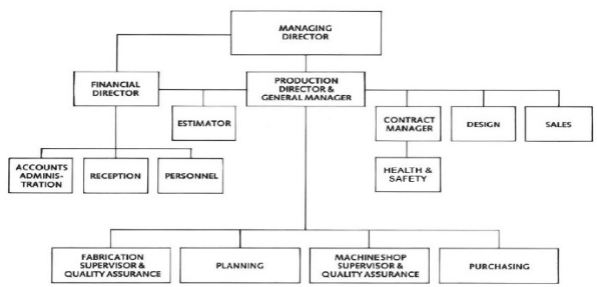
The above figure shows that the whole business is mainly controlled by one person: the Managing Director, because this is a private company or solely owned company. The decision-making power is then entitled to the finance director and general managers, who afterwards control their respective units. Such a simple organizational structure is highly suitable for small organizations where decisions are centralized. Owners of such companies prefer to have stringent control over the business.
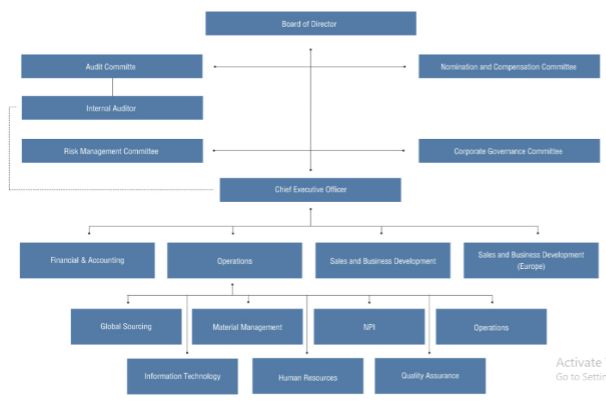
The above figure shows the organisational structure of the public limited company. The organizational diagram clearly shows that it is vast and much more elaborated and detailed than that of a private organization. In such a public company, board of directors make a decision in a democratic manner. There are audit committee and corporate governance team who ensures that the company maintains local laws and regulations.
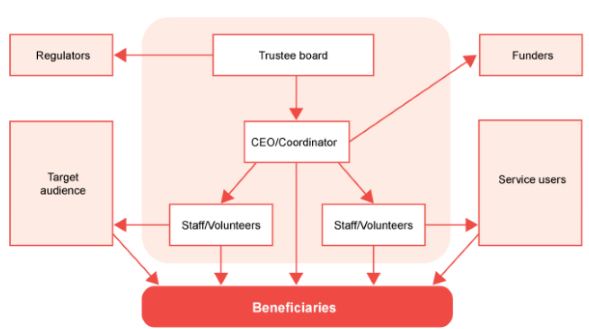
The above figure shows that regulators, funders, and trustee board plays the most important role in a voluntary organization where profits are not the main objectives. In such organizations, volunteers also play a significant role in executing the jobs at the root levels.
Size and scope of different types of organizations:
The below table shows that listed three organizations listed have different sizes, products and scopes. Their objectives are also different. The mission and vision of these organizations largely determine the size, scope, products and services of organizations.
| Name of Organization | Type of organization | Size | Product/Services | Scope |
| Bill and Melinda Gates Foundation | Voluntary organization | Employees: 1489 people Endowment in 2018: $46.8B (Bill and Melinda Gates Foundation, 2020) | Improving healthcare. Education. Removing poverty. | Worldwide operations. |
| Unilever | Public organization | Employees: 155,000 people Revenue in 2019: €51.98B Net Profit: €6.026B (Unilever, 2020) | Food and beverages, personal care products, health and pharmaceuticals, cleaning products etc. | Worldwide operations |
| Zara | Private organization | Locations: 2,270 stores worldwide Revenue in 2018: €18.021B (Inditex, 2018) | Fast fashion clothing, bags, accessories, shoes etc. | Selected markets |
Gates Foundation aims to improve poverty, healthcare, and education of billions of people worldwide by finding a problem and bringing meaningful solutions to solve the problems (Bill and Melinda Gates Foundation-2, 2020). This is the vision statement and purpose of this voluntary organization. This has a close relationship with scope, nature and scale descriptions mentioned in the above table. Such objectives are only possible if the organization is a voluntary one because a for-profit organization would aim to make profits rather than enhance global health. The above table also shows that Gates Foundation has a global scale which is also in line with the vision statement of the Gates Foundation, which outlines that its activities and actions will have a positive impact on global populations.
Unilever aims to be a global leader in the field of sustainable business by improving people’s health and well-being, improving the health of the planet, and contributing more to a socially inclusive world (Unilever-2, 2020). The vision statement outlined by Unilever implies that it is as broad as the information given in the above table about Unilever. The company states itself as a global leader in its domain; thus, the company has business operations globally with more than 150,000 employees working throughout the world. Such large companies should have a well-established organizational structure which Unilever has because this is a public company. A such public company has to comply with organizational structure.
Zara’s vision is to be a fast-fashion and attractive and responsible fashion and improve the quality of customer services (Inditex-2, 2020). This vision statement is much narrower compared to the above two statements from Gates Foundation and Unilever. This is expected because this is a privately held company that has limited expansion and limited objectives.
The interrelationship between organizational functions and organizational structures
Both private and public organizations have similar types of business functions because they aim to make money. However, they have differences in how they operate the business; this difference is clearly reflected in the organizational structure. In general, such businesses have common business functions such as business planning, financial and accounting planning, market research, product development, marketing and branding, HR management etc. (Swift & Piff, 2014). In contrast, a voluntary organization has a different set of functions, such as collecting funds from the donors, making objectives and selecting areas to serve, managing a group of volunteers around the world etc. The importance of these functions is clearly reflected in the organizational structure of the such voluntary organization.
Zara is a privately owned company which emphasizes fast fashion and sustainable businesses. Being fast requires fast decisions and this is only possible if the decision-making process is decentralized and if many people are not involved in the decision-making process. Such a flat decision-making process has helped Zara to be responsive to the market needs in terms of making fast fashion decisions (Inditex, 2018). The such business function has a close association with the organizational structure, which should also be flat and decentralized. The situation is different in the case of Unilever, which is a publicly owned organization which requires a democratic process while making decisions at the higher levels through the board of directors. Corporate strategies are compiled at the highest level through the boards of directors; then, the decisions are implemented at the business functional levels by regional heads. Regional heads of Unilever then adapt the corporate objectives as per the cultural values, and political and socio-economic conditions of respective economies.
In both of the above cases, the company has to emphasize maximizing the interest and return of the shareholders. This implies that the business is run mainly for the highest interest of the owners of the company. The scenario is completely different in the case of the Gates foundation, where the prime interest is to maximize benefits for people of the world suffering from poverty, no education, a dearth of mendicancy services and consultancy. Such businesses also need to convince the donors of the reasons for their philanthropic activities. Therefore, both donors and end service receivers attract great attention in such organizations.
The above analysis clearly shows that organizational functions and organizational structure are strongly associated.
Positive and negative influence of the macro environment on Zara’s operations:
PESTLE Analysis of Zara:
PALMER and HARTLEY (2011) have found in their research that PESTLE is one of the most useful marketing tools that helps companies to analyse the influence of the macro environment. PESTLE analysis of Zara will show the positive and negative impact of the macro environment on their operations which will assist them in taking initiatives in order to interact with the influences appropriately. Zara’s PESTLE analysis is evaluated below:
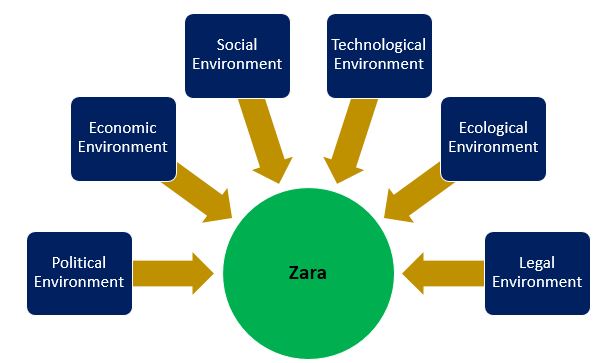
Political Environment: Political environment of Zara will indicate the influence of political factors on its operations, and the company will be able to interact appropriately with the influences. Brexit is one of the political factors that has a negative impact on Zara. For instance, delays in the transit of goods; therefore, the company will not be capable of restocking products in stores and customers will not get products when they need which will harm Zara’s revenue (Fashion Network, 2020).
Economic Environment: This environment will analyse the impact of economic factors on Zara’s operations (The Guardian, 2020). The COVID-19 pandemic has influenced Zara negatively. For instance, People’s income has been reduced because of the recession created by the pandemic; therefore, Zara’s sales have reduced by 44% (The Guardian, 2020). As a result, the profit level of Zara has reduced, and it will take time to recover the loss.
Social Environment: Social environment will indicate the impact of social factors on Zara. (NBC UNIVRSAL, 2020). People often avoid going out without any emergency to save themselves from COVID-19, and it influenced Zara positively. For instance, Zara focused on its online service during COVID-19, and online sales of the company have increased to 95% which helps the company to gain higher revenue than competitors (NBC UNIVRSAL, 2020).
Technological Environment: Zara will be able to identify the impact of technological factors on their operations by analysing the technological environment. The technological environment has a positive impact on Zara and helped the company to grow. For instance, Zara has added its showrooms locations on Google maps; therefore, people find out about their stores easily and visit them (Google Map, 2020). As a result, Zara gets more customers than before and it increased the company’s revenue.
Ecological Environment: Ecological environment will show Zara how the company can reduce their environmental impact to make the world a better place to live. Therefore, the company can enhance customers’ respect toward them and avoid government penalties by taking environmentally friendly steps. For instance, Zara is working on new technologies and new ways to work with recycled materials in order to reduce their environmental impact (Vogue, 2020). Therefore, customers of Zara will be more satisfied after seeing their eco-friendly steps. As a result, they will purchase more from Zara to maintain their loyalty.
Legal Environment: When Zara does not maintain rules and regulations, it creates a bad impact on their operations because governments of host countries interfere with their operations if they break any rules. Whilst, government, do not interfere, and Zara continues their business without any obstacles. Therefore, Zara maintains the rules and regulations of the 96 countries where it operates a business (Forbes, 2020). As a result, the company do not face any legal complexities in executing its operations in host countries.
Internal strengths and weaknesses of Zara
SWOT Analysis of Zara:
WORTHINGTON and BRITTON (2014) have stated that SWOT analysis find out the strengths, weakness, opportunities and threats of organizations and help organizations to take steps to utilize strengths and opportunities furthermore prevent weakness and threats. As a result, companies can make themselves stronger in the targeted markets. By conducting a SWOT analysis, Zara will be able to identify and make proper use of its strengths and opportunities furthermore, prevent weaknesses and threats. The SWOT analysis of Zara has been stated beneath:
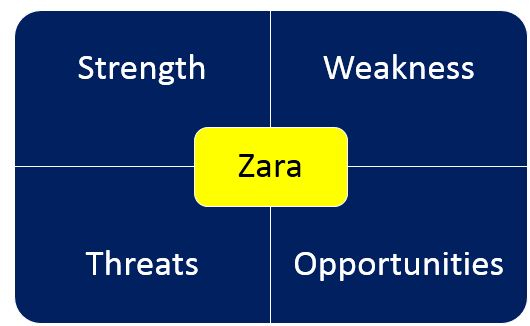
Strengths: Zara maintains a great presence across the world, and it has 3,000 stores in 96 countries (Forbes, 2020). Therefore, customers the countries get Zara’s stores near their hand and shop from the brand more, which makes the company more profitable than its competitors. Zara provides products at a reasonable prices to their competitors and generates $21.9 billion (Forbes, 2020). The reasonable price of Zara increases customers’ attraction toward the brand because they get fashionable dresses within financial capability, and the revenue of the company increases. The company delivers new designs to the stores twice in a week that competitors fail to deliver to the customers (TradeGecko Pte. Ltd, 2020). As a result, Zara remains the top choice of customers among all fashion brands across the world.
Weakness: Zara has a centralized distribution system and controls its suppliers, system, retail stores and distribution; therefore, a single technical hurdle of the distribution network can influence the entire system (Business Insider, 2020). Zara does not create its own designs, and the designer’s copy designs from fashion week; therefore, they cannot deliver unique designs to the customers (Business Insider, 2020). It uses 0 advertising and endorsement policies across the world (Martin Roll Company, 2020). Therefore, many people do not know about Zara and do not purchase from the brand.
Opportunities: Zara does not promote its brand properly but conducting effective promotional strategies such as creative campaigns, social media campaigns, sponsoring competitions etcetera are the ways through which Zara can enhance the publicity of their brand. Among these strategies, social media campaigns will be the most effective way of promoting the company with lower costs than traditional marketing. Many people will know about Zara if the company conduct new marketing strategies, and the revenue of Zara will increase greatly. The company should expand its business in countries like Asia and Africa because these are the fast-growing region of the world and potential markets to make Zara more profitable (CPP LUXURY, 2018).
Threats: Zara faces extreme competition in both local and international levels from brands like H&M, Massimo Dutti and Stradivarius, etcetera (Business Insider, 2020). These competitors conduct different types of marketing strategies, such as providing discounts, lower prices for products, etcetera to get more customers than Zara. H&M has collaborated with an international designers like Karl Lagerfeld and others, whereas Zara has not yet collaborated with any international designer (mds, 2020). Therefore, Zara will not be capable of providing world-class designs that are provided by H&M, which will decrease their customer base.
Explaining the interrelation of strengths and weakness with external macro factors:
Zara has a great presence in 96 countries of the world with its 300o outlets (Forbes, 2020). This strongly indicates its relation with the political environment from the macro environment. Political stability and the government’s fair trade regulations helped Zara to expand its business in their countries and become successful. The great expansion of Zara is also related to the legal environment. Less legal obstacles and complexities helped the company to enter into the host countries and establish its business in the country. Zara generates revenue of $21.9 billion, and it is related to the economic environment (Forbes, 2020). The financial stability of the host countries’ people helped them to afford Zara’s products, and they have become capable of purchasing Zara’s products. As a result, the company became to generate higher revenue. Delivering new designs to the stores twice in a week is Zara’s one of key strengths and it is related to the technological environment. The company utilize the latest technology to produce their products which help the company to produce products within lower time by maintaining quality designs. This quick production process of Zara is also interrelated with an ecological factor because Zara produces too many products and create too much wastage (BBC, 2020). This wastage pollutes land, and the production process of machines pollutes the air by consuming oil.
One of the key weaknesses of Zara is its designers imitate designs from fashion week (Business Insider). This weakness is interrelated with the social environment because Zara understands the change in trends after following the designs of the runways (Business Insider, 2020). The designers need time to research on identifying the trends; therefore, they imitate the runway and save their energy, but it harms the uniqueness of the brand.
Zara does not conduct promotional strategies, but they may be capable of attracting more customers through conducting social media campaigns which refers to the interrelation of the opportunity with the technological environment because social media is an advancement of technology. Expanding business in Asia and Africa to be more profitable is related to the economic environment because fast-growing nature of Asia and Africa is attracting Zara to expand their business (CPP LUXURY, 2018).
Conclusion:
Private, public organizations, and voluntary organizations widely vary in terms of their purpose, structures, and range of stakeholders. Private, and public organizations aim to maximize the benefits of the owners, whilst voluntary organizations aim to maximize the benefits for the target audiences. A voluntary organization generally have a broad objective with a high emphasis on donors and beneficiaries. Whilst private and public organizations, emphasize narrower objectives of increasing their sales and making profits. PESTLE shows that the political factor of Brexit has a negative impact on Zara, like they will get late delivery of goods which will not let them fulfil customers’ demands on time. COVID-19 has brought huge losses for Zara, which will need a long time to restore, but it has increased the online sales of the company. Including showroom locations on Google Maps helped Zara to get more customers because customers could reach the showroom without any hassle. The company is working on being a sustainable business operator by inventing a new ways of doing work and technology in order to reduce its environmental impact, which makes customers loyal to them. Zara maintains all the regulations of host countries that assist them to successfully carry on their business. SWOT shows that Zara has great presence and it is a strong brand which can enhance its growth by conducting effective marketing activities. The company’s key weakness is it imitates designs from the runway, which should be avoided to differentiate its products from competitors. Zara has to provide discounts and maintain the quality of their products to compete strongly in the furious competition among all fashion brands.
References:
Abrahamson, B., R., P., (2020). Zara plans to close more than 1,000 stores to focus on e-commerce. NBC UNIVRSAL. [Online] Retrieved from: https://www.today.com/style/zara-closing-1-000-stores-focusing-online-shopping-t184425 [Assessed On: 1 September, 2020]
BARON, P. (2012) Business and its Environment. 7th Ed. London: Prentice Hall.
Bill and Melinda Gates Foundation, (2020). FOUNDATION FACT SHEET. Retrieved from: https://www.gatesfoundation.org/who-we-are/general-information/foundation-factsheet [Assessed on 2 September 2020]
Bill and Melinda Gates Foundation-2, (2020). Who we are. Retrieved from: https://www.gatesfoundation.org/Who-We-Are [Assessed on 1 September 2020]
Cooper, K., L., (2020). Fast fashion: Inside the fight to end the silence on waste. BBC. [Online] Retrieved from: https://www.bbc.com/news/world-44968561 [Assessed On: 2 September, 2020]
CPP LUXURY, (2018). Africa: the luxury market of the future? [Online] Retrieved from: https://cpp-luxury.com/africa-the-luxury-market-of-the-future/ [Assessed On: 31 August 2020]
Forbes (2020). Zara. [Online] Retrieved from: https://www.forbes.com/companies/zara/#35511b7d7487 [Assessed On: 31 August 2020]
Google Map, (2020). Zara UK. [Online] Retrieved from: https://www.google.com/maps/d/u/0/viewer?gl=US&ie=UTF8&oe=UTF8&msa=0&mid=1BOGt09C9iKjf2U0JmJw1ba0SnhQ&ll=55.9404633004927%2C13.610714492987569&z=5 [Assessed On: 1 September, 2020]
Hanbury, M: 1 (2020). We went inside one of the sprawling factories where Zara makes its clothes. Here’s how the world’s biggest fashion retailer gets it done. Business Insider. [Online] Retrieved from: https://www.businessinsider.com/how-zara-makes-its-clothes-2018-10 [Assessed On: 31 August 2020]
Holgate, M., (2020). As Zara Announces Its Latest Sustainability Goals, Three of Its Design Team Weigh In on Going Slower and Creating Responsibly. Vogue. [Online] Retrieved from: https://www.vogue.com/article/zara-sustainable-initiatives [Assessed On: 1 September, 2020]
Hanbury, M: 2 (2020). Zara and Forever 21 have a dirty little secret. Business Insider. [Online] Retrieved from: https://www.businessinsider.com/zara-forever-21-fast-fashion-full-of-copycats-2018-3 [Assessed On: 2 September, 2020]
mds, (2020). H&M continues its collaboration strategy: allies with Colombian designer Johanna Ortiz. [Online] Retrieved from: https://www.themds.com/companies/hm-continues-its-collaboration-strategy-allies-with-colombian-designer-johanna-ortiz.html [Assessed On: 31 August 2020]
Inditex, (2018). Annual Report. Retrieved from: https://static.inditex.com/annual_report_2018/pdfs/en/Inditex%20Annual%20Report%202018.pdf [Assessed on 1 September 2020]
Inditex-2, (2020). ZARA. Retrieved from: https://www.inditex.com/about-us/our-brands/zara [Assessed on 1 September 2020]
Jolly, J., (2020). Zara owner to close up to 1,200 fashion stores around the world. The Guardian. [Online] Retrieved from: https://www.theguardian.com/business/2020/jun/10/zara-owner-to-close-up-to-1200-fashion-stores-around-the-world [Assessed On: 1 September, 2020]
Longenecker, J. G., Petty, J. W., Palich, L. E., & Hoy, F. (2013). Small business management. Nelson Education.
Martin Roll Company, (2020). The Secret of Zara’s Success: A Culture of Customer Co-creation. [Online] Retrieved from: https://martinroll.com/resources/articles/strategy/the-secret-of-zaras-success-a-culture-of-customer-co-creation/#:~:text=Zara%20has%20used%20almost%20a,in%20opening%20new%20stores%20instead.&text=Instead%20of%20advertising%2C%20Zara%20uses,elements%20of%20its%20marketing%20strategy. [Assessed On: 31 August 2020]
Mira, N., (2020). Inditex believes impact of hard Brexit would not be significant for group. Fashion Network. [Online] Retrieved from: https://uk.fashionnetwork.com/news/Inditex-believes-impact-of-hard-brexit-would-not-be-significant-for-group,1142892.html [Assessed On: 31 August 2020]
PALMER, A. and HARTLEY, B. (2011) The Business Environment. 7th Ed. Maidenhead: McGraw-Hill.
Peck, C., & Reitzug, U. C. (2012). How existing business management concepts become school leadership fashions. Educational administration quarterly, 48(2), 347-381.
Scarborough, N. M. (2016). Essentials of entrepreneurship and small business management. Pearson.
Sampaio, A. R., Thomas, R., & Font, X. (2012). Small business management and environmental engagement. Journal of Sustainable Tourism, 20(2), 179-193.
Swift, L., & Piff, S. (2014). Quantitative methods: for business, management and finance.
Macmillan International Higher Education.
TradeGecko Pte. Ltd, (2020). Zara supply chain analysis – the secret behind Zara’s retail success. [Online] Retrieved from: https://www.tradegecko.com/blog/supply-chain-management/zara-supply-chain-its-secret-to-retail-success [Assessed On: 31 August 2020]
Tyler, J., (2020). We visited H&M and Zara to see which was a better fast-fashion store, and the winner was clear for a key reason. Business Insider. [Online] Retrieved from: https://www.businessinsider.com/hm-zara-compared-photos-details-2018-5 [Assessed On: 31 August 2020]
Unilever, (2020). Annual Report. Retrieved from: https://www.unilever.com/Images/ir-q4-2019-full-announcement_tcm244-543823_en.pdf [Assessed on 2 September 2020]
Unilever-2, (2020). Our Strategy. Retrieved from: https://www.unilever.com/about/who-we-are/our-strategy/ [Assessed on 1 September 2020]
WEATHERLEY, P. (Editor) and OTTER, D. (Editor) (2014) The Business Environment: Themes and Issues in a Globalized World. 3rd Ed. Oxford: Oxford University Press.
